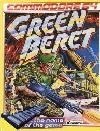Run, jump, crouch, and knife your way through he ultimate cold-war era odyssey. Freedom rock included.
The sum total of the gameplay was to get from one side of the level to the other. Between your blue man (not appearing in Las Vegas) and the finish line were gun soldiers, knife soldiers, mines, and the tan-colored soldiers who turned into power-ups. Each level began with the blue protagonist armed only with a knife. Enemies would come at you from either side in droves and you needed to stab through the horde.
As mentioned, once you succeeded in stabbing the tan soldier you had a power up available. That meant you could pick up one of three weapons: Grenade, pistol, or rocket launcher. Each weapon tended to be level-specific, and had either a limited amount of time it could be used, or finite ammunition. The other power up available was a star which—like its Mario counterpart—would turn you invincible for a time. Thus, you could run over mines push through opponents, and shrug off bullets, explosions and knives as you relentlessly push your way to the end.
Backgrounds were varied and colorful. One level had ICBM (inter-continental ballistic missiles) mounted on large trucks, reminiscent of "Spies Like Us." The snow-swept mountains in the background added to the cold, Siberian feel. Other levels varied, ranging from a tank-filled base to brick-laden cityscapes
Multiplayer, as with most NES games, allowed you and a friend to play through the level together. Friendly fire is turned off. Player 2 was not an identical blue soldier but a similar red soldier. Together you cut a terrible swath of destruction through Siberia.
The high point of the game was definitely the music. It was an infectious ear more that you had to listen to in order to get it out of your head. Music set the entire pace of the game. If one should mute, or turn off the music the game definitely slows down and seems rather repetitive in its delivery. Enemies never really seemed to be smarter; you only faced more of them.
Back in 1988 I remember playing this game for hours, but always wanting to go back and play some more Akari Warriors. Once I had mastered the belly-jump attack, which consisted of crouching, knifing and jumping all at the same time, I realized the enjoyment was gone. While the game was not bad, it wasn’t ground breaking by any means. If you want some simple play with jamming music, this is the back-in-the-day title to play.

